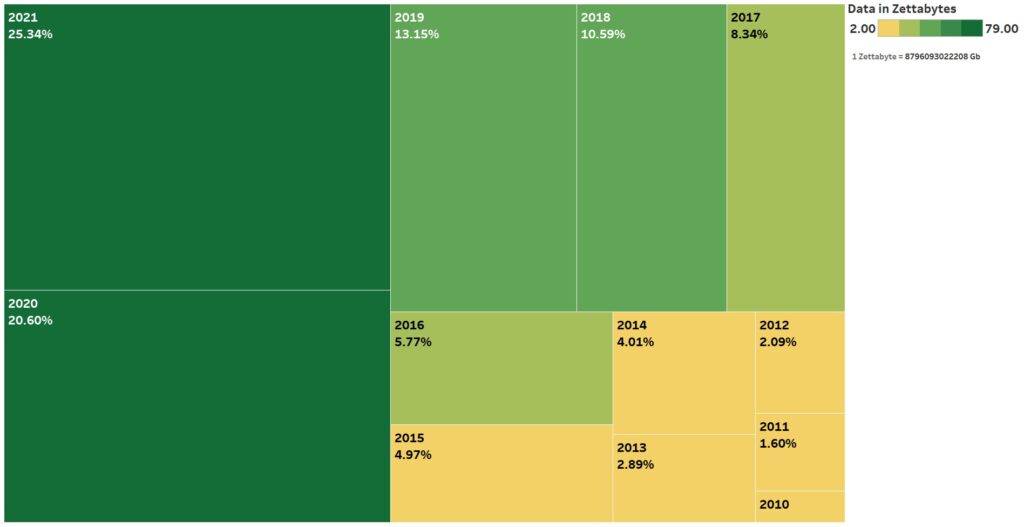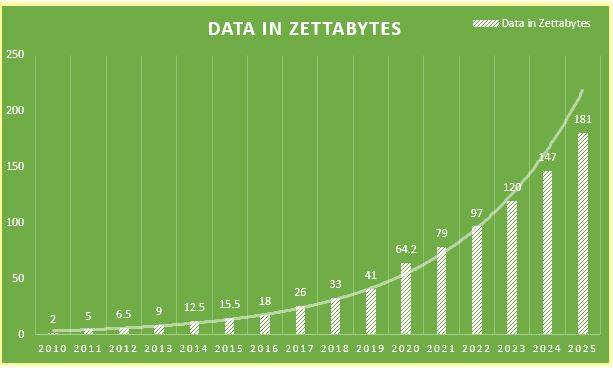“In God we trust, all others must bring data.” – W. Edwards Deming.
2,000,000,000,000,000,000 bytes. The figure is roughly the amount of data generated per day across all industries
Every individual in 2020 created approximately 1.7 megabytes in a second. Which when seen in a bigger picture every day, internet users create 2.5 quintillion bytes of data. Looking at this gigantic source and generation of raw data, the requirement turns out to manage unstructured data by organizations. This seems to be a point of concern by 95 percent of organizations and hence a major share of organizations is (around 97.2 percent) are investing in big data and artificial intelligence.
- According to IBM, in 2020, every person generated 1.7 megabytes per second
- According to big data statistics by Forbes, data production, capture, copying, and consumption increased by 5000% between 2010 and 2020.
- Statista say that in 2020, the big data market grew by 14%
- As per reports, banking and financial sector generates tremendous amount of data, which if calculated on a per second manner will grow 700% in 2021
Big Data
The concept of “big data” means data sets that are in terms of quantity are complicated and huge. Big data are information that includes hidden information such as trends in the market, undiscovered relationships, patterns, consumer preferences, which are required to be discovered. Big data sometimes represents how huge volumes of data are collected and analyzed, enabling companies to make informed business choices. Traditional data processing apps cannot handle big data.
Big data has from many sources, including social media networks, sites (browsers), mobile applications, text messages, geographic sites of wearable devices, other media files, etc., creates and aggregates it as we saw earlier. Sensors and Internet-of-Thing’s (IoT) devices are the major drivers for the growth of the market in Big Data.
The big data market is expected to be valued at 103 billion US dollars globally by the end of 2021. Which is double the size of the market from 2018. The software business, which is 45 percent of the market share, is expected to become the largest data market sector by 2027.

Note: The amount of data taken for 2021 is the predicted total at the end of this year.
The amount of data on the other hand is growing at an alarming rate. We can see from the above Gantt chart that more than 75% (i.e., a total of 2017, 2018, 2019, 2020, 2021 is 78.06%) of the total amount of data present in the world was generated in the last 5 years.

From this bar chart above we can clearly see the exponential rise in the volume of data in the world is unprecedented and predictably will reach more than 180 Zettabytes of data by 2025.
Data are created daily and companies are seeking an innovative approach to organize, manage, analyze and save data so that the competitive advantage is achieved, procedures are simplified and competition remains ahead of time. In a 2016 report from Gartner, companies are using big data to tackle complex business problems and decision making, and over 48% of the companies worldwide were investing in the domain.
The impact of big data on business
With the ever-increasing quantity of data, companies seek creative ways of optimizing Big Data and making decisions using the insights they create. One of the biggest impacts of Big Data on companies is that they are increasingly dependent on the Internet and the amount of data that technology is creating rapidly. The worldwide atmosphere by 2025 is forecast by Seagate IDC to be 175 zettabytes.
Big data delivers accurate information (if properly processed) and brings forth the latest insights for companies to make intelligent and quicker decisions. The big data analysis platforms also enable companies to increase company efficiency, in terms of operations, marketing as well as product development, and gaining a competitive advantage over their competitors.
In addition, companies are striving to improve their income through the use of big data to provide better services to their clients. The basic objective of most organizations is undoubtedly is to enhance the client experience. Among additional goals that may be reached with Big Data must include enhanced marketing strategy, cheaper costs, and more operational efficiency.
Big data has provided companies with social and financial benefits in recent decades, leading to policies that support the growth of Big Data in various governmental bodies.
In various industries such as banking, finance and insurance, retail, manufacturing, logistics, media and business, oil and gas big data is being employed.
The impact of big data on the workforce
Apart from the core business processes big data has a tremendous influence on the workforce of today.
Many companies are currently using the Internet to communicate with their clients, sell and boost productivity. Experienced data scientists, Big Data Engineers, and analysts are thus on demand because they can exploit the huge data sets that are created by the internet.
Numerous colleges and universities are already offering Big Data online classes. This is because data scientists and big data engineers are increasingly in demand. The need for data scientists is predicted to increase by 16 percent by 2028, according to research from India.
Due to the shortage of data scientists and engineers, there is a significant technological gap. The analytical roles of companies are thus still empty in many businesses because they lack technical ability. In the future, we will be able to manage a large number of unstructured data, new software, and technologies, and encounter fewer organizations that lack qualified people to do achieve the same.
As a result, companies depend more on bots and RPAs to automate dull repetitive operations such as data collection, data input, and cleaning data, thus freeing up valuable human resources to do more subjective tasks and gaining insights from big data collected by the company.
The impact of big data on society
Big data influences organizations as we saw, that impacts the economy and that in turn can impact society as a whole as well as the big data technologies themselves. Thus, creating a circle of innovation that benefits all parties. Big data utilization has enhanced the degree of industrial automation, safety, and confidentiality in the manufacturing and healthcare industries.
The weather forecasts, natural catastrophes, urban and community planning, traffic control, logistics and machine efficiency, tailored medical treatment, self-sustaining cars, fraud detention, translation, intelligent housing, robotics, etc. may also be exploited with the help of big data in the coming years and decades.
Big Data Analytics Combined with Machine Learning
The future of big data isn’t solely dependent on the innovations in that specific field. The advancement of big data analytics is heavily linked with the advancements in other related emerging technologies, such as machine learning, artificial intelligence, deep learning, etc.
Focusing on machine learning, we can say that big data is very nicely compatible with the workings of machine learning algorithms. Machine learning algorithms are useful in data analysis and big organization’s integration. It may be performed in many aspects of big data operations such as data labeling and segmentation, data analysis, and simulation of scenarios.
Here are some examples of ways to examine big data using machine learning algorithms:
- Conducting market research and help in segmentation: All enterprises require consumers and understanding their target audience is the top priority for every successful enterprise. Market research and segmentation study are thus a key activity for further exploration of new and present consumers and for gaining valuable knowledge. Machine learning can properly analyse the patterns and behaviour of the target audience utilising supervised and unsupervised algorithms. Machine learning is used by the media and entertainment sector to obtain audiences’ preferences and thus generating content that catches the attention of the customers.
- Customer Behaviour Exploration: Machine learning will continue to assist organisations learn about their consumers and provide a strong foundation for their customers once you have done a research on market and segmentation. This is termed user modelling, a direct outcome of interactions between people and the computer. It leverages data to collect people’ ideas and makes data driven decision making possible for companies. In order to help its users, by comprehending appropriate recommendations, Tech giants such as Facebook, Twitter or Google rely on user modelling systems.
- Personalization of recommendations: Nowadays, customers demand customization. Whether it is a smartphone or a network series, companies must build strong contacts with their consumers so that their experiences are relevant and personalised. Thus, organisations may view their user’s behaviour forecasts in a specific environment in combination with the power of big data and machine learning, thus offering correct suggestions, making modifications at the appropriate moment and enabling consumers to discover interesting suggestions. Netflix is an example of a company that utilises machine learning techniques coupled with big data to provide viewers with appropriate recommendations.
- Trends in forecasting: We can learn and predict future trends as a business via machine learning technologies to analyse Big Data. Machine learning networks can constantly autonomously learn new things and enhance their analytical abilities on a daily basis using networked computers. This allows for data calculation and the application of past experience as an intelligent system for the future.
- Helping decisions to be taken: Machine learning utilises a time series analysis approach that can jointly evaluate a large amount of data. It is a fantastic instrument in which to summarise and analyse data so that management can decide more swiftly in future and take data driven decisions.
According to statistics, digital transformation, technological advancements, and breakthroughs continue to be the primary drivers of the rising amount of big data. Big data is already enormous, but it is anticipated to rise exponentially as new technologies emerge, such as more widespread IoT devices, drones, and wearables, and computing devices increase. Around Ninety percent of the world’s big data has been created in the previous two to three years. With the enormous bulk of raw data; businesses and industries require proper analysis of those unstructured data sources to draw more insights by effectively and efficiently converting them into useful information. Modernization coupled up with rapid industrialization has put much pressure on data culture and mining, hence paving the way to complex analytical tools to culture and introspect data thereby extracting out the essence out it, those recent advancements in deep learning are also helping businesses decipher this valuable trove of information. Big data and business analytics solutions have become mainstream technologies, and they, together with AI and automation, provide the foundation for the digital transformation process.
Blackcoffer Insights 31: Sourojyoti Ghosh and Soumadip Sen, International Management Institute, Kolkata














